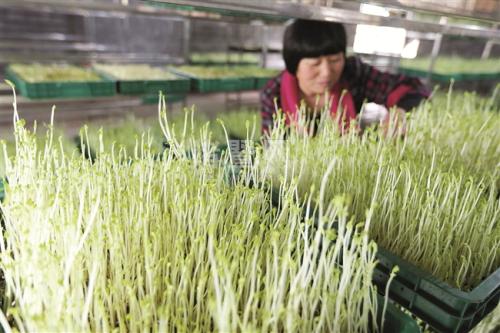How do families grow sprouts? Introduction to the planting method of family sprouts
Planting sprouts can be divided into several kinds, some are suitable for water ploughing, some need to be ploughed with soil, the first to talk about water-ploughed sprouts. Among the sprouts suitable for hydroponics, the most standard and popular sprouts are alfalfa sprouts and mung bean sprouts. In addition, soybeans and black beans can be planted without soil, as long as you buy a container at a horticultural shop or health food store. Some vegetables are suitable for hydroponic and soil ploughing, but soil ploughing tends to grow better, such as red bean sprouts, sunflower seeds and winding bean sprouts.

Seed selection
Those with good quality, high germination rate and no chemical treatment should be selected, because at present, many seeds are imported in bulk, such as soybeans have been irradiated at the time of import, and the germination rate of seeds is very low, so more attention should be paid to the selection and purchase. It must be noted that whether it is for food or planting purposes, you should buy something that has not been irradiated by radiation, because it not only has a high germination rate, but also represents high energy.
Steps of hydroponic cultivation method
a. Soak: soak the seeds at 45-50. C in warm water for 5 minutes can kill a small number of bacteria on the seed surface and reduce bacterial infection. Then change to a cold blister. Please refer to Table 1 for the time.
b. Sprouting: the seeds that are about to be soaked are drained and placed in a cool place for one day to one and a half days or so (depending on different seeds). Small seeds must be germinated, such as alfalfa, sesame, radish baby, wheat, cabbage, mustard; large seeds do not go through the budding stage.
c. Watering and harvesting: the seeds are equally spread to the bottom of the container and watered 3-4 times a day. At this time, attention must be paid to the growth conditions of seeds, such as alfalfa and wheat are temperate crops, if they grow in Taiwan's subtropical climate, especially in summer, they are very easy to rot and mildew, so if you plant this kind of crop, you can water it with ice water, otherwise the sprouts will absorb a lot of chlorine. If the plant cannot see light, it must be planted in a dark place or in an opaque container, so that it can be harvested after watering for 3, 4 or 7 days (depending on the seeds). This is the cleanest sprout!
Steps of soil ploughing and cultivation
The seeds suitable for soil cultivation are wheat, peas and those with high empty germination rate.
First of all, it is necessary to prepare a container with a drainage hole at the bottom, which is suitable for soil cultivation, and then lay peat soil or various media on the petri dish. The medium can be vermiculite, or perlite, or rice, or even cotton and sawdust. Because the nutrients of sprouts come from the seeds themselves rather than from the soil, the main function of the medium is only to support it. It should be noted that when sprinkling the medium, such as peat soil, it should be soaked in water so that it can fully absorb water before laying it, while a few people use wet towels instead of the medium.
Soak the seeds in warm water for 5 minutes, then soak them in cold water (see Table 1 for time). The soaked seeds are placed on the medium and covered with a lid to avoid light, because most of the seeds do not need to see light at the beginning of germination. After that, water 3-4 times a day, wait for cotyledons to grow, take off the lid, plant in less strong sunlight, water 3-4 times a day, about 7-8 cm long, and the whole process takes about 4-7 days (depending on different sprouts).
- Prev

Food rumors in moments: what are the hazards of recent food rumors and food rumors?
The Food Hygiene Department also called on the public to maintain "reasonable doubt" about the rumors on the Internet, to confirm that the rumors should be stopped by the wise beforehand, and not to re-transmit and spread them. If it is difficult to tell the true from the false, you can provide the relevant information to the Food Hygiene Department or go online.
- Next

What are the modern agricultural science and technology: the three treasures of agricultural science and technology, the product of the development of agricultural science and technology
The agricultural testing institute vegetable and fruit cultivation greenhouse uses double net and pest control walkway design to reduce the pest problem in the greenhouse, and by adjusting the plant spacing of crop cultivation, reserve the movement space of small agricultural machinery and tools, not only the number of cultivation per unit area has not been reduced, but also can cooperate with agricultural machinery and tools.
Related
- A one-day flower show brings 130 million yuan in orders! Nanhai, this Phalaenopsis exhibition is amazing
- What do the flower language and meaning of Lutheran tree mean? Precautions for planting Lutheran tree
- Encounter Chaoshan Kongfu tea, not without this cup of Phoenix single clump
- The durian market in Vietnam and Thailand is flooded. The price of imported durian has plummeted by 30-40% in a month.
- Shanghai solved the problem of local vegetable supply by planting 80,000 mu of green leafy vegetables.
- Wageningen University has become the best agricultural university in the world for the seventh time in a row.
- The strongest export season of South African grapes is full of challenges, with exports to Russia falling sharply by 21%.
- Sri Lanka is on the verge of bankruptcy, "Tea for debt" Organic Agriculture Revolution aggravates the Food crisis?
- Turning waste into earthworm manure and worm manure into organic fertilizer-A new choice for auxiliary farming
- Organic rice growers shoulder the responsibility of nurturing agricultural talents! Yinchuan Sustainable Farm with Organic Life Camp

